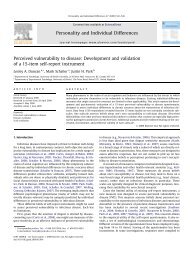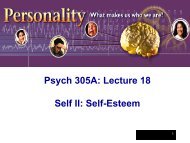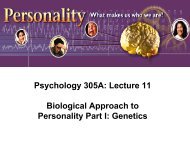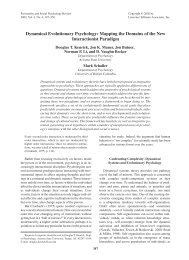Culture and the Self: Implications for Cognition, Emotion, and ... - iacmr
Culture and the Self: Implications for Cognition, Emotion, and ... - iacmr
Culture and the Self: Implications for Cognition, Emotion, and ... - iacmr
You also want an ePaper? Increase the reach of your titles
YUMPU automatically turns print PDFs into web optimized ePapers that Google loves.
238 HAZEL ROSE MARKUS AND SHINOBU KITAYAMA<br />
interdependent relationship with ano<strong>the</strong>r person. If <strong>the</strong> o<strong>the</strong>r<br />
person accepts one's amae, <strong>the</strong> reciprocal relationship is symbolically<br />
completed, leading to a significant <strong>for</strong>m of self-validation.<br />
If, however, <strong>the</strong> o<strong>the</strong>r person rejects one's amae, <strong>the</strong> relationship<br />
will be in jeopardy.<br />
For <strong>the</strong> purpose of comparing indigenous feelings, such as<br />
amae, with <strong>the</strong> more universal ones, such as anger <strong>and</strong> happiness,<br />
Kitayama <strong>and</strong> Markus (1990) used a multidimensional<br />
scaling technique, which allows <strong>the</strong> identification of <strong>the</strong> dimensions<br />
that individuals habitually or spontaneously use when<br />
<strong>the</strong>y make judgments about similarities among various emotions.<br />
Recent studies have demonstrated that people are capable<br />
of distinguishing among various emotions on as many as<br />
seven or eight cognitive dimensions (Mauro, Sato, & Tucker,<br />
1989; C. Smith & Ellsworth, 1987). In <strong>the</strong>se studies, however,<br />
<strong>the</strong> dimensions have been specified a priori by <strong>the</strong> experimenter<br />
<strong>and</strong> given explicitly to <strong>the</strong> respondents to use in describing<br />
<strong>the</strong> emotions. When <strong>the</strong> dimensions are not provided but<br />
allowed to emerge in multidimensional scaling studies, only<br />
two dimensions are typically identified: activation (or excitement)<br />
<strong>and</strong> pleasantness (e.g., Russell, 1980). And it appears that<br />
most Western emotions can be readily located on a circumplex<br />
plane defined by <strong>the</strong>se two dimensions. Thus, although people<br />
are capable of discriminating among emotions on a substantial<br />
number of dimensions, <strong>the</strong>y habitually categorize <strong>the</strong> emotions<br />
only on <strong>the</strong> dimensions of activation <strong>and</strong> pleasantness.<br />
More recently, Russell (1983; Russell, Lewicka, & Niit, 1989)<br />
applied <strong>the</strong> same technique to several non-Western cultural<br />
groups <strong>and</strong> replicated <strong>the</strong> American findings. He thus argued<br />
that <strong>the</strong> lay underst<strong>and</strong>ing of emotional experience may indeed<br />
be universal. Russell used, however, only those terms that have<br />
clear counterparts in <strong>the</strong> non-Western groups he studied. He<br />
did not include any emotion terms indigenous to <strong>the</strong> non-Western<br />
groups such as amae. It is possible that once terms <strong>for</strong> such<br />
indigenous feeling states are included in <strong>the</strong> analysis, a new<br />
dimension, or dimensions, may emerge. To explore this possibility,<br />
Kitayama <strong>and</strong> Markus (1990) sampled 20 emotions from <strong>the</strong><br />
Japanese language. Half of <strong>the</strong>se terms were also found in English<br />
<strong>and</strong> were sampled so that <strong>the</strong>y evenly covered <strong>the</strong> circumplex<br />
space identified by Russell. The remaining terms were<br />
those indigenous to Japanese culture <strong>and</strong> those that presuppose<br />
<strong>the</strong> presence of o<strong>the</strong>rs. Some (e.g., fureai [feeling a close connection<br />
with someone else]) refer primarily to a positive association<br />
with o<strong>the</strong>rs (ra<strong>the</strong>r than events that happen within <strong>the</strong> individual,<br />
such as success), whereas o<strong>the</strong>rs refer to interpersonal<br />
isolation <strong>and</strong> conflict (e.g., oime [<strong>the</strong> feeling of indebtedness]).<br />
Japanese college students rated <strong>the</strong> similarity between 2 emotions<br />
<strong>for</strong> each of <strong>the</strong> 190 pairs that could be made from <strong>the</strong> 20<br />
emotions. The mean perceived similarity ratings <strong>for</strong> <strong>the</strong>se pairs<br />
were <strong>the</strong>n submitted to a multidimensional scaling.<br />
Replicating past research, Kitayama <strong>and</strong> Markus (1990)<br />
identified two dimensions that closely correspond to <strong>the</strong> activation<br />
<strong>and</strong> <strong>the</strong> pleasantness dimensions. In addition, however, a<br />
new dimension emerged. This third dimension represented <strong>the</strong><br />
extent to which <strong>the</strong> person is engaged in or disengaged from an<br />
interpersonal relationship. At <strong>the</strong> interpersonal engagement<br />
end were what we have called o<strong>the</strong>r-focused emotions, such as<br />
shame, fureai [feeling a close connection with somebody else],<br />
<strong>and</strong> shitashimi [feeling familiar], whereas at <strong>the</strong> disengagement<br />
end were found some ego-centered emotions, such as pride <strong>and</strong><br />
tukeagari [feeling puffed up with <strong>the</strong> sense of self-importance],<br />
along with sleepiness <strong>and</strong> boredom. This interpersonal engagement-disengagement<br />
dimension also differentiated between<br />
o<strong>the</strong>rwise very similar emotions. Thus, pride <strong>and</strong> elation were<br />
equally positive <strong>and</strong> high in activation, yet pride was perceived<br />
as considerably less interpersonally engaged than elation. Fur<strong>the</strong>rmore,<br />
anger <strong>and</strong> shame were very similar in terms of activation<br />
<strong>and</strong> pleasantness, but shame was much higher than anger<br />
in <strong>the</strong> extent of interpersonal engagement.<br />
More important, this study located <strong>the</strong> indigenous emotions<br />
within <strong>the</strong> three-dimensional structure, permitting us to underst<strong>and</strong><br />
<strong>the</strong> nature of <strong>the</strong>se emotions in reference to more universal<br />
emotions. For instance, amae was low in activation, <strong>and</strong><br />
nei<strong>the</strong>r positive nor negative, fairly akin to sleepiness, except<br />
that <strong>the</strong> <strong>for</strong>mer was much more interpersonally engaged than<br />
<strong>the</strong> latter. This may indicate <strong>the</strong> passive nature of amae, involving<br />
<strong>the</strong> hopeful expectation of ano<strong>the</strong>r person's favor <strong>and</strong> indulgence<br />
without any active, agentic solicitation of <strong>the</strong>m. Completion<br />
of amae depends entirely on <strong>the</strong> o<strong>the</strong>r person, <strong>and</strong>, <strong>the</strong>re<strong>for</strong>e,<br />
amae is uniquely ambivalent in its connotation on <strong>the</strong><br />
pleasantness dimension. Ano<strong>the</strong>r indigenous emotion, oime,<br />
involves <strong>the</strong> feeling of being psychologically indebted to somebody<br />
else. Oime was located at <strong>the</strong> very negative end of <strong>the</strong><br />
pleasantness dimension, perceived even more negatively than<br />
such universal negative emotions as anger <strong>and</strong> sadness. The<br />
extreme unpleasantness of oime suggests <strong>the</strong> aversive nature of<br />
unmet obligations <strong>and</strong> <strong>the</strong> press of <strong>the</strong> need to fulfill one's obligations<br />
to o<strong>the</strong>rs <strong>and</strong> to return favors. It also underscores <strong>the</strong><br />
significance of balanced <strong>and</strong> harmonious relationships in <strong>the</strong><br />
emotional life of those with interdependent selves.<br />
The finding that <strong>the</strong> Japanese respondents clearly <strong>and</strong> reliably<br />
discriminated between ego-focused emotions <strong>and</strong> o<strong>the</strong>rfocused<br />
emotions on <strong>the</strong> dimension of interpersonal engagement<br />
versus disengagement strongly suggests <strong>the</strong> validity of this<br />
distinction as an essential component of emotional experience<br />
at least among Japanese <strong>and</strong>, perhaps, among people from<br />
o<strong>the</strong>r cultures as well. In a more recent study, Kitayama <strong>and</strong><br />
Markus (1990) fur<strong>the</strong>r tested whe<strong>the</strong>r this <strong>the</strong>oretical dimension<br />
of emotion also underlies <strong>and</strong> even determines how frequently<br />
people may experience various emotions <strong>and</strong> whe<strong>the</strong>r<br />
<strong>the</strong> frequency of emotional experience varies with <strong>the</strong>ir dominant<br />
construal of self as independent or interdependent.<br />
Kitayama <strong>and</strong> Markus (1990) first sampled three emotions<br />
common in Japanese culture that were expected to fall under<br />
one of <strong>the</strong> five types <strong>the</strong>oretically derived from <strong>the</strong> current analysis.<br />
These types are listed in Table 2. Ego-focused positive<br />
emotions (yuetukan [feelingsuperior], pride, <strong>and</strong> tukeagari [feeling<br />
puffed up] are those that are most typically associated with<br />
<strong>the</strong> confirmation or fulfillment of one's internal attributes, such<br />
as abilities, desires, <strong>and</strong> needs. Ego-focused, negative emotions<br />
(anger, futekusare [sulky feeling], <strong>and</strong> yokyufuman [frustration])<br />
occur primarily when such internal attributes are<br />
blocked or threatened. Also included were those correspondingly<br />
positive or negative emotions associated with <strong>the</strong> maintenance<br />
or enhancement of interdependence. Thus, three emotions<br />
are commonly associated with <strong>the</strong> affirmation or <strong>the</strong> completion<br />
of interdependent relationships (fureai [feeling of<br />
connection with someone], shitashimi [feeling of familiarity to







